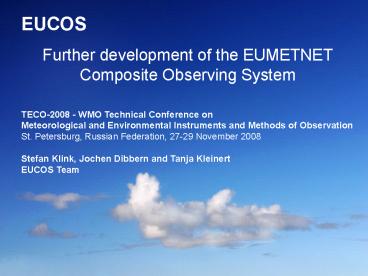EUMETNET - PowerPoint PPT Presentation
1 / 21
Title:
EUMETNET
Description:
Selected European radiosonde stations. Selected European synoptic weather stations ... The radiosonde network is still the most important component of the ground based ... – PowerPoint PPT presentation
Number of Views:63
Avg rating:3.0/5.0
Title: EUMETNET
1
EUCOS
Further development of the EUMETNET Composite
Observing System
- TECO-2008 - WMO Technical Conference on
- Meteorological and Environmental Instruments and
Methods of Observation - St. Petersburg, Russian Federation, 27-29
November 2008 - Stefan Klink, Jochen Dibbern and Tanja Kleinert
- EUCOS Team
www.free-stockphotos.com
2
Content
- About EUMETNET and EUCOS
- EUCOS objectives
- The current EUCOS network
- Studies Programme
- Space-Terrestrial study and recommendations
derived from it - EUCOS upper-air network redesign
- PREVIEW Data Targeting System
- Future plans
3
About EUMETNET and EUCOS (1)
4
About EUMETNET and EUCOS (2)
EUCOS OPERATIONAL PROGRAMME
E-AMDAR
Fully integrated programmes
E-ASAP (including OWS M and Ekofisk)
E-SURFMAR (surface marine buoys and VOS)
WINPROF
Integration in 2008
Territorial Segment (upper air and RBSN stations)
Collaborative components
Operations Monitoring
Managed by EUCOS team
Studies Programme
Possible Future Programmes
Evolving needs
Observation Targeting
Programme Components
5
EUCOS Information System ( www.eucos.net )
6
EUCOS objectives (1)
EUCOS Serving the Regional Scale NWP
requirement for observations over the European
region
Warnings and Info Services
Climate, Climate prediction
7
EUCOS objectives (2)
- Design and coordinate the evolution of the ground
based EUMETNET composite observing system (EUCOS)
to be optimized at European scale with a view to
improve short range forecast over Europe without
increasing the overall cost - Monitor and control EUCOS performance
- Ensure integrated management for agreed
components such as E-ASAP, E-AMDAR, E-SURFMAR
(and WINPROF) - Support the evolution of EUCOS through a
studies programme
8
EUCOS objectives (3)
EUCOS area (10N-90N, 70W-40E)
9
The current EUCOS network (1)
- All European ships of the Automated Ship
Aerological Programme ASAP(10 E-ASAP integrated,
5 national) - All measurements from European commercial
aircraft (AMDAR) - Ocean weather ship M and Ekofisk oil platform
- Selected moored buoys and all European drifting
buoys - European Voluntary Observing Ships
- Selected European radiosonde stations
- Selected European synoptic weather stations
10
The current EUCOS network (2)
E-ASAP RS ascents on a 2 x 2 grid during 2007
11
The current EUCOS network (3)
E-AMDAR
12
The current EUCOS network (4)
E-SURFMAR EGOS then EUCOS drifting buoys,
average number of hourly observations per day
13
EUCOS network performance 2007
14
Studies Programme
- Impact Studies as a measure to guideline the
evolution of EUCOS - (External) drivers and developments
- Different observation networks evolve differently
(e.g. regarding availability, accuracy, cost,
...) - Data assimilation algorithms improve and can make
use of more data - EUCOS objective
- Design and coordinate the evolution of the ground
based EUCOS to be optimized at European scale
with a view to improve short range forecast ... - ? A modification of the meteorological observing
network might become necessary - EUCOS needs approval for network changes or
modifications from PB-OBS and EUMETNET Council
respectively - In order to get the 24 Members convinced of such
changes it was decided to base them on scientific
analyses (e.g. impact studies)
15
Space-Terrestrial Study and recommendations
derived from it (1)
- Motivation need to better understand the
relative contribution of satellite and
ground-based observations so that the total
system may be progressively optimised - five European NWP centres agreed running
Observation System Experiments (OSE), thereby
relying on common scenarios, time periods and
verification procedures - The following scenarios were defined
- Baseline all current satellite observations used
in NWP GUAN radiosonde network hourly GSN
surface land data hourly buoys (no ship data) - Control full combined observing system
- And different additions to the Baseline
(radiosondes, wind profiler, aircraft
measurements).
16
Space-Terrestrial Study and recommendations
derived from it (2)
The studies lead to a list of general
conclusions, compiled at the 2007 E-SAT meeting
(complete list can be found in the proceedings)
- Compared to Baseline all additional ground based
observing systems have a positive impact on the
forecast skill. On top of the additional
available satellite data further improvements of
the ground based observing system are important. - The radiosonde network is still the most
important component of the ground based upper-air
observing network. - The impact of aircraft measurements is
significant and second largest ... - AMDAR humidity is seen as a high priority
project. - ...
17
EUCOS upper-air network redesign (1)
- Motivation
- Significant evolution of the European AMDAR
network - Members were not able to install the proposed
EUCOS radiosonde network design with 4 ascents
per day at most of the sites - Results from the Space Terrestrial Studies are
available with recommendations for the network
design
18
EUCOS upper-air network redesign (2)
Proposed OSE scenarios
19
PREVIEW Data Targeting System
- Aim of data targeting make additional
observations when and where they will be most
beneficial to subsequent forecasts - A pre-operational Data Targeting System (DTS) has
been developed to assess the feasibility of
operational adaptive control of the observing
system - 50 / 50 funding from EUCOS and EC
- 505 high impact cases were proposed and 446
accepted by the lead user - During 11 months trial period 87 of requested
radiosonde ascents from land stations had been
deployed - DTS is described in the latest issue of the
ECMWF newsletter
20
Future plans
21
Questions and Comments?
www.free-stockphotos.com































